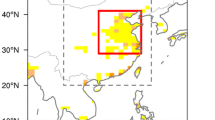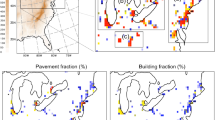Abstract
The effect of urbanization on local climate is quantified by numerical simulations for five desert cities that represent a wide range of urban size, climate zone, and composition of land cover. Land-use land cover maps generated from Landsat data for 1985 and 2010, chosen as the start and end of a period of rapid urbanization, are used to constrain the surface boundary conditions for the numerical model. In this manner, this study focuses on the particular aspect of the effect of land-use changes on local climate. Within this scope, the results reveal a pattern of the climatic effect of desert urbanization with nighttime warming and weaker, but significant daytime cooling. This effect is confined to the urban area and is not sensitive to the size of the city or the detailed land cover types in the surrounding areas. The pattern is identified in both winter and summer. Exceptions to this pattern are found in a small number of cases when the noisiness of local circulation, specifically monsoon and land–sea breeze, overwhelms the climatic signal induced by land-use changes. The inter-cities’ differences in the temperature response to land-use change are also discussed.








Similar content being viewed by others
References
Best MJ, Grimmond CSB (2015) Key conclusions of the first international urban land surface model comparison project. Bull Am Meteor Soc 96:805–819
Brazel A, Selover N, Vose R, Heisler G (2000) The tale of two climates—Baltimore and Phoenix urban LTER sites. Clim Res 15:123–135. doi:10.3354/cr015123
Brazel A, Gober P, Lee SJ, Grossman-Clarke S, Zehnder J, Hedquist B, Comparri E (2007) Determinants of changes in the regional urban heat island in metropolitan Phoenix (Arizona, USA) between 1990 and 2004. Clim Res 33:171–182
Caldwell P, Chin H-NS, Bader DC, Bala G (2008) Evaluation of WRF dynamical downscaling simulation. Clim Change 95:499–521. doi:10.1007/s10584-009-9583-5
Carnahan WH, Larson RC (1990) An analysis of an urban heat sink. Remote Sens Environ 33:65–71
Chavez PS Jr (1996) Image-based atmospheric corrections: revisited and improved. Photogramm Eng Remote Sens 62:1025–1036
Chen F, Tewari M, Kusaka H, Warner TT (2006) Current status of urban modeling in the community Weather Research and Forecast (WRF) model. In: Joint sixth symposium on the urban environment and ams forum: managing our physical and natural resources: successes and challenges, Atlanta, GA, USA, Amer. Meteor. Soc. CD-ROM. J1.4
Chen F, Kusaka H, Bornstein R, Ching J, Grimmond CSB, Grossman-Clarke S, Loridan T, Manning KW, Martilli A, Miao S, Sailor D, Salamanca FP, Taha H, Tewari M, Wang X, Wyszogrodzki AA, Zhang C (2011) The integrated WRF/urban modelling system: development, evaluation, and applications to urban environmental problems. Int J Climatol 31:273–288
Diffenbaugh NS (2009) Influence of modern land cover on the climate of the United States. Clim Dyn 33:945–958. doi:10.1007/s00382-009-0566z
Erell E, Williamson T (2007) Intra-urban differences in canopy layer air temperature at a mid-latitude city. Int J Climatol 27:1243–1255
Georgescu M, Miguez-Macho G, Steyaert LT, Weaver CP (2009) Climatic effects of 30 years of landscape change over the Greater Phoenix, Arizona, region: 1. Surface energy budget changes. J Geophys Res 114:D05110. doi:10.1029/2008JD010745
Georgescu M, Moustaoui M, Mahalov A, Dudhia J (2011) An alternative explanation of the semiarid urban area “oasis effect”. J Geophys Res. doi:10.1029/2011JD016720
Heikkila U, Sandvik A, Sorteberg A (2011) Dynamical downscaling of ERA-40 in complex terrain using the WRF regional climate model. Clim Dyn 37:1551–1564. doi:10.1007/s00382-010-0928-6
IPCC (2013) Climate change (2013) the physical science basis. In: Stocker TF, Qin D, Plattner G-K, Tignor M, Allen SK, Boschung J, Nauels A, Xia Y, Bex V, Midgley PM (eds) Contribution of working group I to the fifth assessment report of the intergovernmental panel on climate change. Cambridge University Press, Cambridge, United Kingdom and New York, NY, USA, p 1535
Kamal S, Huang H-P, Myint SW (2015) The influence of urbanization on the climate of Las Vegas metropolitan area: a numerical study. J Appl Meteorol Climatol 54:2157–2177. doi:10.1175/JAMC-D-15-003.1
Kusaka H, Kimura F (2004) Coupling a single-layer urban canopy model with a simple atmospheric model: impact on urban heat island simulation for an idealized case. J Meteorol Soc Jpn 82:67–80
Kusaka H, Kondo H, Kikegawa Y, Kimura F (2001) A simple single-layer urban canopy model for atmospheric models: comparison with multi-layer and slab models. Bound Layer Meteorol 101:329–358
Kusaka H, Hara M, Takane Y (2012) Urban climate projection by the WRF Model at 3 km horizontal grid increment: dynamical downscaling and predicting heat stress in the 2070’s August for Tokyo, Osaka, and Nagoya Metropolises. J Meteorol Soc Jpn 90B:47–63. doi:10.2151/jmsj.2012-B04
Lazzarini M, Marpu PR, Ghedira H (2013) Temperature-land cover interactions: the inversion of urban heat island phenomenon in desert city areas. Remote Sens Environ 130:136–152
Leung LR, Mearns LO, Giorgi F, Wilby RL (2003) Regional climate research: needs and opportunities. Bull Am Meteorol Soc 84:89–95
Li D, Bou-Zeid E, Barlage M, Chen F, Smith JA (2013) Development and evaluation of a mosaic approach in the WRF-Noah framework. J Geophys Res Atmos 118:11918–11935. doi:10.1002/2013JD020657
Mearns LO, Arritt R, Biner S, Bukovsky MS, McGinnis S, Sain S, Caya D, Correia J, Flory D, Gutowski W, Takle ES, Jones R, Leung R, Moufouma-Okia W, McDaniel L, Nunes AMB, Qian Y, Roads J, Sloan L, Snyder M (2012) The North American regional climate change assessment program: overview of phase I results. Bull Am Meteorol Soc 93:1337–1362
Miller JA (2011) Urban and regional temperature trends in Las Vegas and southern Nevada. J Ariz Nev Acad Sci 43:27–39
Myint SW, Wentz EA, Brazel AJ, Quattrochi DA (2013) The impact of distinct anthropogenic and vegetation features on urban warming. Landsc Ecol 28:959–978
Myint SW, Zheng B, Talen E, Fan C, Kaplan S, Middel A, Smith M, Huang H-P, Brazel A (2015) Does the spatial arrangement of urban landscape matter? Examples of urban warming and cooling in Phoenix and Las Vegas. Ecosyst Health Sustain 1:art15. doi:10.1890/EHS14-0028.1
National Research Council (2012) Urban meteorology: forecasting, monitoring, and meeting user’s needs. The National Academies Press, Washinton, p 176
Oke TR (1982) The energetic basis of the urban heat island. Q J R Meteorol Soc 108:1–24
Pan L, Chen S, Cayan D, Hart M, Zhang Q, Liu Y, Wang J (2011) Influence of climate change on the California and Nevada regions revealed by a high-resolution dynamical downscaling study. Clim Dyn 37:2005–2020. doi:10.1007/s00382-010-0961-5
Pielke RA Sr, Pitman A, Niyogi D, Mahmood R, McAlpine C, Hossain F, Goldewijk KK, Nair U, Betts R, Fall S, Reichstein M, Kabat P, de Noblet N (2011) Land use/land cover changes and climate: modeling analysis and observational evidence. Wiley Interdiscip Rev Clim Change 2:828–850
Potchter O, Itzhak Ben-Shalom H (2013) Urban warming and global warming: combined effect on thermal discomfort in the desert city of Beer Sheva, Israel. J Arid Environ 98:113–122
Rasul A, Balzter H, Smith C (2015) Spatial variation of the daytime surface urban cool island during the dry season in Erbil, Iraqi Kurdistan, from Landsat 8. Urban Clim 2(Part 2):176–186
Runnalls KE, Oke TR (2000) Dynamics and controls of the near-surface heat island of Vancouver. British Columbia. Phys Geogr 21:283–304
Sardeshmukh PD, Compo GP, Penland C (2000) Changes of probability associated with El Nino. J Clim 13:4268–4286
Sharma A, Huang H-P (2012) Regional climate simulation for Arizona: impact of resolution on precipitation. Adv Meteorol. doi:10.1155/2012/505726
Shashua-Bar L, Pearlmutter D, Erell E (2009) The cooling efficiency of urban landscape strategies in a hot dry climate. Landsc Urban Plan 92:179–186
Skamarock WC, Klemp JB, Dudhia J, Gill DO, Barker DM, Duda MG, Huang XY, Wang W, Powers JG (2008) A description of the advanced research WRF version 3, NCAR Tech. Note NCAR/TN-475 + STR. National Center for Atmospheric Research, Boulder, p 125
United Nations Environment Programme (UNEP) (2006) Global deserts outlook, archived at www.unep.org/pdf/Global_Deserts_Outlook.pdf, p 164
Yang J, Wang ZH (2014) Physical parameterization and sensitivity of urban hydrological models: application to green roof systems. Build Environ 75:250–263
Zheng B, Myint SW, Fan C (2014) Spatial configuration of anthropogenic land cover impacts on urban warming. Lands Urban Plan 130:104–111
Acknowledgements
This work was supported in part by National Aeronautics and Space Administration Grant NNX12AM88G. The authors appreciate useful comments from anonymous reviewers. Early results of this paper were reported in the first author’s PhD Dissertation (Arizona State University).
Author information
Authors and Affiliations
Corresponding author
Ethics declarations
Conflict of interest
The authors declare no conflict of interest.
Rights and permissions
About this article
Cite this article
Kamal, S., Huang, HP. & Myint, S.W. Numerical simulations to quantify the diurnal contrast in local climate trend induced by desert urbanization. Environ Syst Decis 38, 261–273 (2018). https://doi.org/10.1007/s10669-017-9657-2
Published:
Issue Date:
DOI: https://doi.org/10.1007/s10669-017-9657-2




